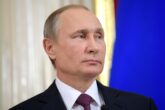September 17, 2019
Trump’s Defense Cuts in Europe Will Backfire
Twice this month, the Trump administration moved to walk back critical efforts to strengthen the U.S. military presence in Europe, choosing cheap political points over essential projects and sound policy. First, the White House announced it would cut more than $770 million worth of military construction efforts meant to restore combat capability in Europe and to deter further Russian aggression, in order to divert funds to build a wall on the U.S.-Mexico border. Second, the United States is hoping to cut a deal with Germany that on its face appears to increase German military spending and decrease the U.S. share of the military burden in Europe but, in reality, serves to weaken the German military while burdening the United States even further. In both cases, the loser is the United States.
The military construction projects on the chopping block include vital aspects of the U.S. scramble to rebuild its ability to fight in Europe. As the U.S. deputy assistant secretary of defense in charge of Europe and NATO when Russia invaded Ukraine in 2014, I spent almost every waking moment pushing as much U.S. force structure back into Europe as I could to deter any further aggression by Russian President Vladimir Putin. I know firsthand how essential the projects in question are, and I know for a fact that eliminating them takes away tools the U.S. military needs in case of a conflict, including ammunition storage, runways for combat aircraft, facilities for special operations forces, prepositioned equipment to set up forward air bases, and reinforced shelters for combat aircraft. The projects being cut are not military bands or barber shops but tools of war that would be needed immediately in case of conflict. Deterrence is about not just showing intent to defend your allies, but having the ability to do so. These cuts take away that ability. The U.S. drawdown in Europe at the end of the Cold War helped embolden Putin to invade Georgia and Ukraine, as well as intimidate U.S. allies in the Nordic and Baltic regions. To deter further Russian adventurism in this great power competition, the United States’ ability to respond alongside NATO needs to be restored, and quickly.
Read the full article in Foreign Policy.
More from CNAS
-
The Eurasian Century: Hot Wars, Cold Wars, and the Making of the Modern World with Hal Brands
For more than 100 years, the continent of Eurasia has played a central role in global geopolitics. In the 20th century, numerous authoritarian powers from Germany under Kaiser...
By Andrea Kendall-Taylor, Jim Townsend & Hal Brands
-
Putin’s Fight Won’t End With Ukraine
In an essay for Foreign Affairs, titled “Putin’s Point of No Return,” Andrea Kendall-Taylor, senior fellow and director of the Transatlantic Security Program at the Center for...
By Andrea Kendall-Taylor
-
Trump’s Callout of Russia’s Vladimir Putin Is Raising Eyebrows
President Trump is threatening sanctions and tariffs on Russia if Putin doesn't reach an agreement to end the war in Ukraine. Some are surprised, considering Trump's affinity ...
By Andrea Kendall-Taylor
-
In Russia's Perceived War with the West, Arms Control is Collateral Damage
Russia seemingly perceives previously established arms control agreements as elements of the broader Western-dominated political and security order that it aims to overturn....
By Nicholas Lokker




